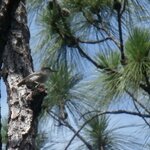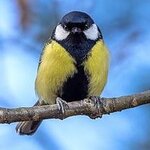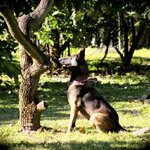Ecology & Zoology

What factors sustain the diversity of life on our planet? You might be surprised to learn one answer is sexual harassment.
But in a new Journal of Ecology paper, the author proposes a new mechanism sustaining coexistence between competitive species, referred to as "sexual conflict" or "harassment". In the context of the life sciences, this is defined as when one sex of an organism -- usually male -- attempts to increase its fertilization success rate at the expense of the fertility of mating partners. In other words, it notes that evolution does not always maximize population…

By Nala Rogers, Inside Science -- When do you need a broadsword, and when would you be better off with a dagger? That's the question that faced artiodactyls, the group of mammals that includes deer, antelope, goats, giraffes, pigs, buffalo and cows, during their evolution.
Many male artiodactyls fight over females using weaponized body parts such as horns and antlers. But pigs and several groups of deerlike animals have tusks instead, and a few species have both. Water deer have tusks so pronounced they are nicknamed "vampire deer."
To understand this variation, researchers compared the…

Lyme disease is the most prevalent tick-borne disease and is caused by the bacterial spirochete Borrelia. Using the Centers for Disease Control and Prevention (CDC) recommended two-tier method, Garg et al., claim that 72 percent of individuals they examined classified "negative" by the CDC two-tier lyme disease test showed positive for the Borellia biomarker, and other microbes such as Babesia, Bartonella, and Ehrlichia.
That means some lyme disease patients do not follow the "one microbe, one disease" Germ Theory, according to an analysis of patients at different disease stages which found…

In my back yard I have three bluebird houses and a Koi pond which over the years have brought my family and I countless hours of calm, natural serenity. Over the last few years however I have noticed a few disturbing trends including the total absence of frogs in my pond and few, if any bluebirds.
I wondered if this was a local phenomenon or something more global…
According to Yale Environment 360, Over the years 1989-2014 entomologists set up insect traps over the western German state of North Rhine-Westphalia.
The results were astounding. The average biomass of insects caught in the…

Dog owners think dogs are exceptionally intelligent - a whole television show was made about a dog named Lassie who got humans out of all kinds of fantastic situations - while cat owners believe the same about their pets.
But are dogs smarter than other animals or pets? Not really, according to a review of over 300 papers which compared the brain power of dogs with other domestic animals, other social hunters and other carnivorans (which includes dogs, wolves, bears, lions, hyenas, and more).
The review focused on sensory cognition, physical cognition, spatial cognition, social…

The Bahama Nuthatch, native to a small area of native pine forest on the island of Grand Bahama, was feared extinct after Hurricane Matthew in 2016, but researchers are pleased to announce that the little-known bird is still out there.
But there may be only two left, they worry.
The Bahama Nuthatch has a long bill, a distinctive high-pitched squeaky call, and nests only in the mature pine trees of the Caribbean island. There may have been a sharp decline in its estimated population, from a believed 1,800 reported in a survey in 2004 to just 23 being seen in a survey in 2007, but it is hard…

Ground sharks (Carcharhiniformes) are the most diverse shark group living today, with over 200 different species, and they are one of the major groups that survived the Cretaceous–Palaeogene mass extinction which is why we have the Tiger, Hammerhead, and Blacktip Reef sharks and lamniforms by the Great White and Mako sharks.
Before the mass extinction that killed-off non-bird dinosaurs and marked the end of the Cretaceous period and the Mesozoic era 66 million years ago, dinosaurs dominated terrestrial environments and Mackerel sharks (Lamniformes) were the dominant shark forms of the sea.…

Impulse control is associated with larger cognitively advanced animals like humans and other primates, but there are exceptions, like ravens. Now a recent study shows that the great tit, a common European songbird, has a tremendous capacity for self-control - almost the same as chimpanzees.
Biologists learned this by placing food in a small translucent cylinder. The great tits that started pecking at the cylinder to get to the food failed the test as the behavior was considered an impulsive act. Those that, on the other hand, moved to an opening in the cylinder and thereby were able to…

Mounting levels of atmospheric carbon dioxide reduce the medicinal properties of milkweed plants that protect monarch butterflies from disease, according to a recent experiment.
Milkweed leaves contain bitter toxins that help monarchs ward off predators and parasites. The study looked at how elevated carbon dioxide levels alter plant chemistry and how those changes, in turn, affect interactions between monarchs and their parasites. Milkweed is the sole food of monarch caterpillars. In a multi-year experiment, researchers grew four milkweed species with varying levels of those protective…

If a study has 229 trials and there are only 12 false positives, that is a good result.
That happened, with dogs, detecting laurel wilt-affected wood from avocado trees. Man's best friend showed capability of high level performance, even in harsh weather conditions such as high heat and humidity. Thanks to the surge in popularity among younger people (and those who choose to ruin sushi) avocado is the second-largest tree crop in Florida behind citrus. But laurel wilt disease, here thanks to an an invasive species (the redbay ambrosia beetle) which arrived here from Asia in untreated…